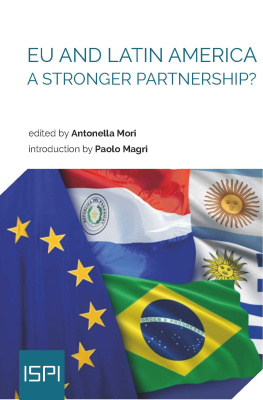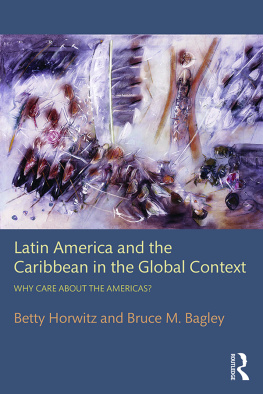Introduction
Latin America is at a crossroads. Scholars have used this trite catchphrase several times in the past. And after all, with the epidemic of the novel coronavirus (SARS-CoV-2) morphing into a pandemic and going global, which countries and regions of the world cannot be said to be at a crossroads?
Yet, this is all the more true for todays Latin America and the Caribbean (LAC) region. The region is experiencing new transformations in political, economic, and societal terms. In turn, all these rapid changes are having an impact on how LAC countries shape their own foreign policies, and on how they adapt to the challenges of an increasingly multipolar world.
First, Latin America is at a crossroads both politically and strategically. During the Cold War and beyond, LAC countries had two choices: either be loyal followers of the United States, or side with the socialist bloc headed by the Soviet Union. Of course, this was not always a clear choice. However, it could often determine the fate of governments, through coups, guerrillas, foreign interference, or mass protests. Today, the old world is gone and a new one has risen from its ashes. After the short hiatus of the 1990s and early 2000s, when Latin American countries were left with the US as their main partner (or opponent), and the EU was much further away, LAC countries today face a renewed bipolar competition between the US and China, with the EU at the margins. Beijings rising heft has been the subject of hundreds of articles. Most agree that Chinas influence has shifted over time from pre-eminently economic to more political, on par with Beijings newfound assertiveness on the world stage. At the same time, Chinas tools for political influence have remained in large part economic and financial (such as debt financing), and this allows for sharp comparisons with another pre-eminently economic actor in terms of influence: the EU and its member states. As this Report will show, Brussels has not managed to properly leverage its economic heft in the region.
Second, Latin American countries are (or, better, continue to be) at a crossroads in terms of political institutions, as they grapple with the benefits and costs of democracy, and are constantly tempted by autocratic setbacks or, to the very least, democratic retrenchment. The past few years have shown how hard it can be to preserve democracy in one of the regions that has been most prone to regime change since the Second World War, apart from Sub-Saharan Africa. In 2019, as unrest in Venezuela continued, protests against austerity and political corruption swept through South America, involving Argentina, Peru, Ecuador, Chile, Bolivia, and Colombia. The violent ousting of Bolivias then-President Evo Morales in November, following elections that according to the Organization of American States were clearly manipulated, shows how hard it can be to preserve and bolster democratic institutions in the region.
Third, Latin America is at a crossroads economically. Much has changed since the end of the Cold War, but some things have remained the same. The LAC region today counts a number of countries whose rising economic status has been formally acknowledged. Three of them, Argentina, Brazil, and Mexico, are members of the G20, with Chile also a permanent guest of the summit. Brazil itself is the worlds ninth biggest economy, vying with Italy for eighth place. Moreover, despite persistent inequalities in income and wealth, many citizens are now much richer than they were in the recent past. Three decades after the end of the Cold War, Mexicans are now on average 34% richer in real terms, Brazilians 38%, and Argentines 61%. Such rapid improvements have taken place despite recurrent economic crises. After its 2001 default, Argentina remains constantly on the brink. Brazil experienced a prolonged recession between 2014 and 2016, followed by stagnation. Finally, Mexicos growth is pretty steady, but Trumps blunt tactics in trade renegotiations and the current oil price crash pose a challenge to a country marred by violence and disappointing structural reforms.
In the face of all these changes, this Report asks two related questions. First, how are the United States, the EU, and China adapting their foreign policies to the old and new realities of the LAC region? Second, how are some of the main countries in the region (namely Brazil, Mexico, and Venezuela) responding, or contributing to determine such a constantly shifting scenario?
There is no doubt that Trumps election came with the expectation of a different US approach to the Latin American region. This is why in the first chapter Loris Zanatta asks: what has really changed over the past four years? How did Trumps arrival affect the US stance towards Latin America? Or, to put it more bluntly: does the Trump administration actually have a specific foreign policy towards Latin America? During the election campaign, Trump railed against Latino migrants, pledged to build a wall along the border, and envisaged trade renegotiations with many countries. Four years on, it seems that the impression that the US President only has a short-term strategy vis--vis Latin America is well founded. This short-termism has had a profound impact on how each Latin American country has tried to cope with a neighbouring superpower that has become less and less predictable.
While the US appear to have decided to devoid only a limited amount of time towards the region, Europe appears to be playing the long game. As Gian Luca Gardini argues, at the start of 2019 EU-Latin America relations appeared to have reached a stalemate. But, by the end of the year, prospects for a re-launch were surprisingly and paradoxically more promising. Brexit, the large influx of Venezuelan asylum seekers reaching Europe, the wave of protests that shook the entire region, and the need to counterbalance Trumps rhetoric have spurred a number of new initiatives. The new European Commission has signalled a renewed willingness to engage with LAC countries, especially on trade and public diplomacy, while Germany has even announced a new policy towards the region as a whole. Barring the unexpected (and still uncertain, but surely profound) impact of the ongoing global pandemic, EU-Latin America relations appear set for a further deepening albeit always in the shadow of the two giants, the US and China.
Turning to Beijing, Mario Esteban and Ugo Armanini show how China-Latin America trade and investment ties have skyrocketed since the early 2000s. China-LAC relations have been mainly economic, as the 2015-2019 China-LAC Cooperation Plan has targeted US$500 billion in bilateral trade and US$250 billion in bilateral foreign direct investment by 2025. But the cooperation has grown more political over time, as evidenced by the 10 strategic partnerships that China has signed with LAC countries (including Brazil, Mexico, Argentina and Chile), and more recently by the enlargement of the Belt and Road Initiative (BRI). Ultimately, Chinas relations with several Latin American countries appear to have entered a new stage, as Beijings engagement has become multidimensional (economic, political, institutional, and even military), with global and regional implications, opportunities and risks. It remains to be seen whether long-terms concerns about increasing dependence on Chinas credit lines, as well as Beijings reassessment of the sustainability of its own outreach, will lead to a strengthening or loosening of China-LAC ties in the near future.













